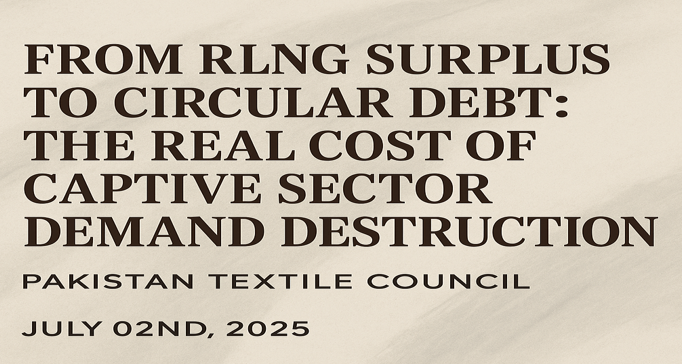Annual Meeting of Pakistan Textile Council – 30th August 2025 – Karachi
From RLNG Surplus To Circular Debt: The Real Cost of Captive Sector Demand Destruction
admin
July 2, 2025
Blog

Writer: MR. ASIM RIAZ AN ESTABLISHED ENERGY EXPERT, M.PHIL. STRATEGIC STUDIES NDU,MASTERS IN ENERGY MANAGEMENT CIIT, B.SC. (MECHANICAL) UET, BS. MATH-PHYSICS PU.
Captive buyers have the capacity to offtake up to 400 MMCFD of RLNG; however, the RLNG supplied to these consumers is priced significantly higher than its landed cost, often by more than PKR 1,000 per MMBtu. For instance, while the delivered ex-ship (DES) price of LNG was $8.10 per MMBtu, the tariff charged to captive consumers stood at $15.38 per MMBtu. This substantial pricing disparity has led to complete demand destruction within the captive power sector, rendering it economically unviable to continue RLNG-based operations under the current pricing structure.
When these surplus cargoes are diverted to the international spot market instead, the entire commercial benefit is retained by the suppliers under the terms of long-term Sale and Purchase Agreements (SPAs) with QatarGas (QG) and Qatar Petroleum (QP), now operating as QatarEnergy. These SPAs offer limited operational flexibility. For example, three cargoes from QG and two from QP have been deferred from 2025 to 2027 under downward quantity flexibility provisions. However, there is no flexibility with respect to profit-sharing.
Any upside from spot sales is not passed on to the buyer, while financial losses from distressed sales are absorbed by Pakistan State Oil (PSO), further burdening the domestic energy system. In the case of ENI, a portion of the commercial benefit is reportedly shared with Pakistan LNG Limited (PLL), though the structure and scale of this benefit remain undisclosed. Unfortunately, the net value retained by PLL is minimal, and no part of this limited gain is reflected in any pricing relief for end consumers.
The current arrangement lacks financial transparency and fails to deliver any tangible economic benefit to the domestic market, despite the growing challenges facing the RLNG supply chain. SNGPL’s system intake has declined significantly over the past two years, falling from 840 MMCFD to 532 MMCFD. This sharp reduction has led to stranded RLNG volumes, increasing financial strain on the gas system.
The decline in industrial RLNG demand, estimated at 450 MMCFD, has forced SNGPL to divert approximately 92,594 BBTU of expensive RLNG to low-revenue residential sectors. This volume is equivalent to nearly 250 MMCFD or 30 LNG cargoes. As a result, RLNG diversion costs have surged to Rs. 299.936 billion, reflecting an 84 percent increase from the Rs. 162.5 billion cost allowed by OGRA for FY 2024–25.
These diversions primarily serve subsidized residential consumers and reflect structural imbalances in the current gas allocation framework. To recover these losses, SNGPL submitted its FY 2025–26 Estimated Revenue Requirement (ERR) petition to OGRA on April 18, 2025. In the petition, the utility proposed a tariff hike of Rs. 707.37 per MMBtu, increasing the prescribed gas price from Rs. 1,778.35 to Rs. 2,485.72 per MMBtu. This proposed increase is mainly driven by the cost of diverting RLNG to heavily subsidized residential users.
OGRA, through Decision No. OGRA-6(2)-1(2)/2024-MFR, approved an additional increase of Rs. 116.90 per MMBtu in the prescribed gas tariff for SNGPL consumers. However, unless corrective actions are taken through reallocation and tariff restructuring, these additional cost recoveries will not resolve the systemic inefficiencies. Diversion costs will continue to accumulate and contribute to the growing circular debt. This will further weaken liquidity in the exploration and production sector.
To prevent further deterioration, APTMA urges the Federal Government to reallocate surplus RLNG to industrial consumers through a ring-fenced, market-based tariff framework. This would enhance financial transparency, promote efficient gas utilization, and reduce the long-term fiscal burden on the energy sector. Note that capacity payment for coal-fired power plants, at PKR 44.56 per kWh, is approximately 27 times higher than the PKR 1.65 per kWh provided to captive power generation, which includes both fixed and variable operation and maintenance costs. Levy calculation over and above Captive Gas tariff of PKR 3500 per MMBtu is attached, which makes tariff over $15 per MMBtu. It is better to shift to Irani LPG or Coal than Qatari or US LNG, thanks to IMF!
Recent Posts
News
Blog
Have Any Question?
- +92 51 2726971
- info@ptc.org.pk
